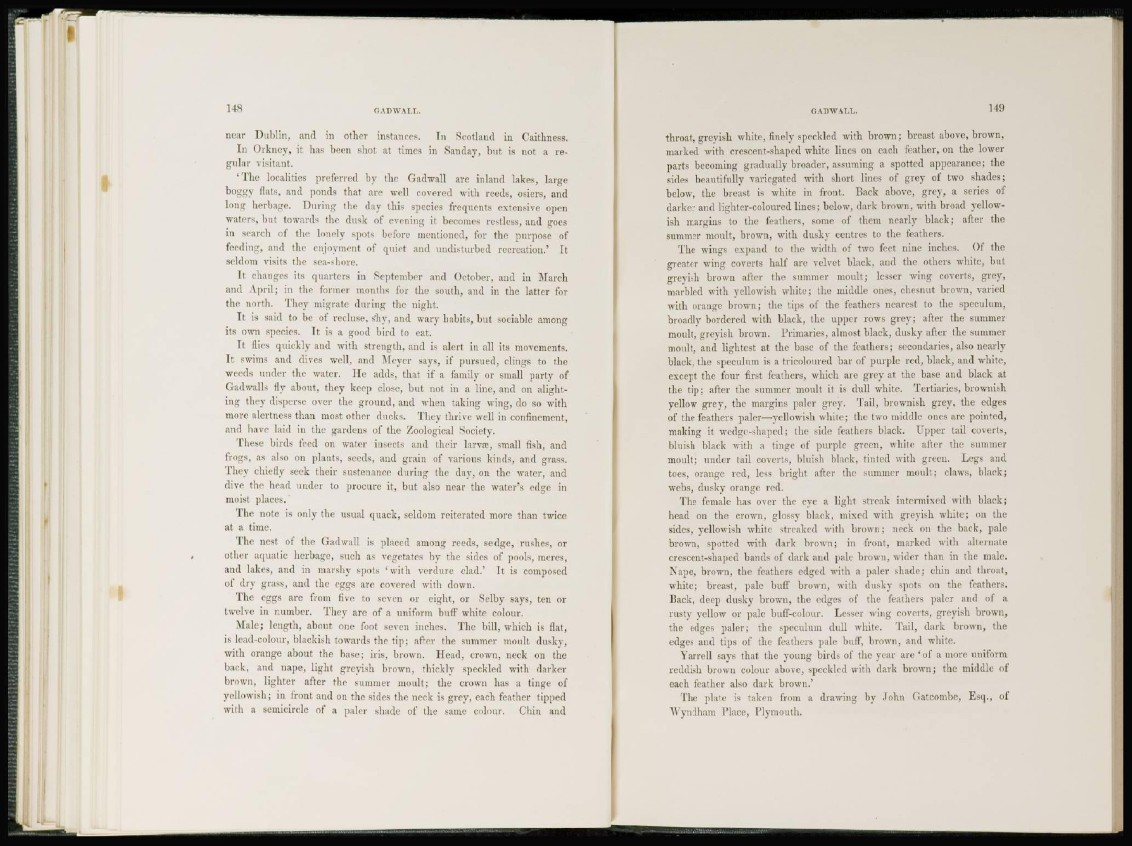
1 is QADWAIL.
near Dublin, and in other instances. In Scotland in Caithness.
In Orkney, it has been shot at times in Sanday, but is not a regular
visitant.
' The localities preferred by the Gadwall are inland lakes, large
boggy Hats, and ponds that are well covered with reeds, osiers, and
long herbage. During the clay this species frequents extensive open
waters, but towards the dusk of evening it becomes restless, and goes
in search of the lonely spots before mentioned, for the purpose of
feeding, and the enjoyment of quiet and undisturbed recreation.' It
seldom visits the sea-shore.
It changes its quarters in September and October, and in March
and April; in the former months for the south, and in the latter for
the north. They migrate during the night.
I t is said to be of recluse, s"hy, and wary habits, but sociable among
its own species. It is a good bird to eat.
It flies quickly and with strength, and is alert in all its movements.
I t swims and dives well, and Meyer says, if pursued, clings to the
weeds under the water. He adds, that if a family or small party of
Gadwalls fly about, they keep close, but not in a line, and on alighting
they disperse over the ground, and when taking wdng, do so with
more alertness than most other ducks. They thrive well in confinement,
and have laid in the gardens of the Zoological Society.
These birds teed on water insects and their larva;, small fish, and
frogs, as also on plants, seeds, and grain of various kinds, and grass.
They chiefly seek their sustenance during the day, on the water, and
dive the head under to procure it, but also near the water's edge in
moist places.
The note is only the usual quack, seldom reiterated more than twice
at a time.
The nest of the Gadwall is placed among reeds, sedge, rushes, or
other aquatic herbage, such as vegetates by the sides of pools, meres,
and lakes, and in marshy spots 1 with verdure clad.' It is composed
of dry grass, and the eggs are covered with down.
The eggs are from five to seven or eight, or Sclby says, ten or
twelve in number. They are of a uniform huff white colour.
Male; length, about one foot seven inches. The bill, which is flat,
is lead-colour, blackish towards the tip; after the summer moult dusky,
with orange about the base; iris, brown. Head, crown, neck on the
back, and nape, light greyish brown, thickly speckled with darker
brown, lighter after the summer moult; the crown has a tinge of
yellowish; in front and on the sides the neck is grey, each feather tipped
with a semicircle of a paler shade of the same colour. Chin and
GADWALL. 1 19
throat, greyish white, finely speckled with brown; breast above, brown,
marked with crescent-shaped white lines on each feather, on the lower
parts becoming gradually broader, assuming a spotted appearance; the
sides beautifully variegated with short lines of grey of two shades;
below, the breast is white in front. Back above, grey, a series ol
darker and lighter-coloured lines; below, dark brown, with broad yellowish
margins to the feathers, some of them nearly black; after the
summer moult, brown, with dusky centres to the feathers.
The wings expand to the width of two feet nine inches. Of the
greater wing coverts half are velvet black, and the others white, but
greyish brown after the summer moult; lesser wing coverts, grey,
marbled with yellowish wdiite; the middle ones, chesnut brown, varied
with mange brown; the tips of the feathers nearest to the speculum,
broadly bordered with black, the upper rows grey; after the summer
moult, greyish brown. Primaries, almost black, dusky after the summer
moult, and lightest at the base of the feathers; secondaries, also nearly
black, the speculum is a tricoloured bar of purple red, black, and white,
except the four first feathers, which are grey at the base and black at
the tip; after the summer moult it is dull white. Tertiaries, brownish
yellow grey, the margins paler grey. Tail, brownish grey, the edges
of the feathers paler—-yellowish white; the two middle ones are pointed,
making it wedge-shaped; the side feathers black. Upper tail coverts,
bluish black with a tinge of purple green, white alter the summer
moult; under tail coverts, bluish black, tinted with green. Legs and
toes, orange red, less bright after the summer moult; claws, black;
webs, dusky orange red.
The female has over the eye a light streak intermixed with black;
head on the crown, glossy black, mixed with greyish white; on the
sides, yellowish white streaked with brown; neck on the back, pale
brown, spotted with dark brown; in front, marked with alternate
crescent-shaped bands of dark and pale brown, wider than in the male.
Nape, brown, the feathers edged with a paler shade; chin and throat,
white; breast, pale buff brown, with dusky spots on the feathers.
Hack, deep dusky brown, the edges of the feathers paler and of a
rusty yellow or pale buff-colour. Lesser wing coverts, greyish brown,
the edges paler; the speculum dull wdiite. Tail, dark brown, the
edges and tips of the feathers pale buff, brown, and wdiite.
\ arrell says that the young birds of the year are 'of a more uniform
reddish brown colour above, speckled with dark brown; the middle of
each feather also dark brown.'
The plate is taken from a drawing by John Gatcombe, Esq., of
\\ yiulham 1'lace, Plymouth.